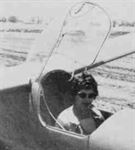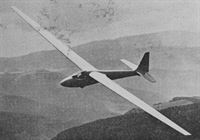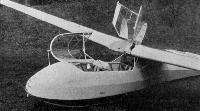
Варианты
- Schleicher - Ka.6 / K.7 / K.8 - 1955 - Германия
- FFA - Diamant - 1964 - Швейцария
- Schleicher - ASK 13 - 1966 - Германия
- Schleicher - ASK 14 / ASK 16 - 1967 - Германия
- Schleicher - ASK 18 - 1974 - Германия
M.Hardy. Gliders & Sailplanes of the world
Schleicher Ka 6CR
Designed by Rudolf Kaiser and developed by Rudolf Hesse, the Ka 6 series of single-seat Standard Class sailplanes may, perhaps more than any other German type, lay claim to being the true postwar successor of the famous DFS Meise or Olympia. The Ka 6 first flew in prototype form in November 1955, with a wing span of 14m (45ft 11 in), and the type's high performance and attractive price led to steady sales and widespread use in contest flying; more than 1,400 Ka 6s had been built when production ceased in 1968, and the type has been widely exported. In 1956, when the Standard Class regulations were revised, the wing span was increased to 15m (49ft 2 1/2 in), this version being the Ka 6B with a landing skid under the fuselage, and the Ka 6BR with a non-retractable monowheel in place of the skid. The Ka 6C has modified wing roots and an underfuselage landing skid, while the Ka 6CR is the same but with a monowheel in place of the skid. At the 1958 World Championships at Leszno in Poland, a Ka 6 flown by Heinz Huth of Germany came 3rd in the Standard Class, and Rudolf Kaiser was awarded the prize for the best sailplane design in this class for the Ka 6. A Ka 6CR flown by Heinz Huth took 1st place in this class in both the 1960 World Championships in Germany and the 1963 World contest at Junin in Argentina; 16 of the 35 Standard Class entries in 1960 were Ka 6s, which took 2nd, 4th 5th and 6th places, and in 1963 22 out of 38 Standard Class entries were also Ka 6s. In the 1965 world contest, the best position gained by a Ka 6CR was 6th place, taken by W. Scott of the USA. Of conventional wooden construction with ply and fabric covering, the Ka 6 has cantilever high-set single-spar wings of pine and plywood, covered with fabric; they have a forward sweep of 1° 12' and 3° of dihedral. Schempp-Hirth air brakes are fitted and the wooden ailerons are plywood-covered. The wooden semi-monocoque fuselage is also ply-covered, and the cantilever tail unit is of similar construction to the wings, and a trim tab in the elevator is an optional fitting. The Ka 6CR has a non-retractable unsprung monowheel with a band-brake, and both the Ka 6C and CR have a tailskid. The pilot sits under a one-piece blown Plexiglas canopy just ahead of the wing leading edge.
An Australian-built version of the Ka 6CR was produced by Edmund Schneider Pty Ltd, the makers of the prewar Grunau Baby, who had transferred their operations to Australia after the war. Known as the ES Ka 6, this licence-built Australian version first flew in December 1961, and had many changes to suit Australian conditions. The keefer main spar was retained, but the rest of the structure was changed to spruce. The monowheel was enlarged to allow interchangeability with that of the ES 52 Kookaburra, and a new sideways-hinging metal-framed Perspex canopy was introduced. Lifting handles were also provided at the nose and tail. Schneider built seven ES Ka 6s, and was planning to start a further batch of four late in 1964, but production was ended apparently before the latter were built. Schneider also built a few Ka 7 two-seaters under licence.
Data: Ka 6CR
Span: 49 ft 2 1/2 in
Length: 21 ft 10 in
Height: 5 ft 1 1/2 in
Wing area: 133.5 sqft
Aspect ratio: 18.1
Empty weight: 419 lb
Max weight: 661 Ib
Max speed: 124 mph
Max aero-tow speed: 87 mph
Min sinking speed: 2.26 ft/sec at 42 mph
Best glide ratio: 29:1 at 50 mph
Schleicher Ka 6E
The Ka 6E Standard Class single-seater differs from the Ka 6CR in having a revised wing with modified leading edge profile and mounted just a little bit lower on the fuselage, a slightly different fuselage profile of 10% less cross-sectional area, a slightly longer cockpit canopy lowered by three inches and a redesigned tail unit, with a taller fin and rudder and a low-set all-moving tailplane; the latter is the same (except for the lack of trim tabs) as on the Ka 10, which did not go into production and was a modified Ka 6CR with the tailplane moved to about one-third of the way up the fin. Like the CR, the Ka 6E has Schempp-Hirth air brakes, and tailplane stability and trimming are controlled by a single lever which adjusts the spring tension on the control column; glassfibre wing tips are featured. The Ka 6E first flew in the spring of 1965, the same year that the Ka 10 took part in the World Championships at South Cerney, and the E version likewise took part in many national championships and other contests. It is of the same wooden construction with ply and fabric covering as the Ka 6CR, and the landing gear is the same except that the monowheel is now retractable.
Data: Ka 6E
Span:49 ft 2 1/2 in
Length: 21 ft 10 in
Height: 5 ft 3 in
Wing area: 133.5 sqft
Aspect ratio: 18.1
Empty weight: 430 lb
Max weight: 661 lb
Max speed: 124 mph (in smooth air)
Max aero-tow speed: 87 mph
Min sinking speed: 2.17 ft/sec
Best glide ratio: 34:1 at 50 mph
Schleicher Ka 7
This tandem two-seater training and club sailplane was designed by Rudolf Kaiser to succeed the wooden two-seater Ka 2 and Ka 2B which had proved to be popular trainers in Germany and had been Kaiser's first design for the Alexander Schleicher firm which he had joined in 1952. The Ka 7 first flew in prototype form in 1959 and was intended to provide not only basic training but continuation training without a break for pilots graduating to the more advanced high performance sailplanes. In this it was successful and a total of 370 had been built by the spring of 1964; Ka 7s twice set new German distance records and the type also set a new German goal flight record for two-seaters over a decade after it first appeared. Of conventional wood and fabric construction, with a steel tube fuselage which had fabric covering over wooden formers, the Ka 7 is characterised by high cantilever wings with a forward sweep of 6° 36' at the quarter-chord line and 4° dihedral. The single-spar wings are of pine and plywood with fabric covering and a plywood-covered leading edge torsion box; there are Schempp-Hirth air brakes above and below the wings and the wooden ailerons are fabric-covered. The cantilever tail unit is of similar construction to the wings, and there is a trim tab in the starboard elevator. Landing gear consists of a non-retractable and unsprung Dunlop monowheel and a nose skid forward of it carried on rubber blocks for shock absorbtion; there is also a tailskid. The two pilots sit under a Plexiglas canopy the front portion of which hinges to starboard and the rear portion hinges rearwards.
Span: 52 ft 6 in
Length: 26 ft 7 in
Wing area: 188.4 sqft
Aspect ratio: 14.6
Empty weight: 617 lb
Max weight: 1,058 lb
Max speed: 124 mph (in smooth air)
Max aero-tow speed: 81 mph
Min sinking speed: 2.66 ft/sec at 43.5 mph
Best glide ratio: 26:1 at 50 mph
Schleicher Ka 8
This training and club sailplane is basically a single seater version of the tandem two-seater Ka 7; designed by Rudolf Kaiser, it also owes something to the Ka 6 series but has a simpler structure, very similar to that of the Ka 7, which makes it suitable for amateur construction. The prototype Ka 8 made its first flight in November 1957 and over 1,100 have now been built in three main versions; in its original form the Ka 8 had a very small cockpit canopy, the second version had windows in the sides of the cockpit for improved visibility, and the third version, the Ka 8B, has a larger one-piece blown Plexiglas canopy under which the pilot sits. The cantilever high wings are single-spar structures of pine and plywood, with a plywood leading edge torsion box and fabric covering aft of the spar; their forward sweep is 1°18' and dihedral is 3°. There are Schempp-Hirth air brakes in the upper and lower surfaces and the wooden ailerons are plywood-covered. The cantilever tail unit is of similar construction to the wings, with ply-covered fixed surfaces and fabric-covered rudder and elevators, and a trim tab in the elevator is an optional fitting. The fuselage is a welded steel tube structure, with fabric covering over spruce longerons and a glassfibre nose cone. There is a non-retractable and unsprung monowheel, with no brake, and a nose skid mounted on rubber blocks in front of it, plus a steel spur at the tail. A motor glider conversion of the Ka 8B is being offered by LVD (the Flying Training School of the Detmold Aero Club) similar to their conversion of a Scheibe Bergfalke IV known as the BF IV-BIMO, in which a Lloyd LS-400 piston engine mounted in the fuselage drives a pair of small two-blade pusher propellers rotating within cutouts in each wing near the trailing edge.
Data: Ka 8B
Span: 49 ft 2 1/2 in
Length: 23 ft 0 in
Height: 5ft 1 3/4 in
Wing area: 152.3 sqft
Aspect ratio: 15.9
Empty weight: 419 lb
Max weight: 683 lb
Max speed: 124 mph (in smooth air)
Max aero-tow speed: 81 mph
Min sinking speed: 2.1 ft/sec at 37.5 mph
Best glide ratio: 27:1 at 45:5 mph
- M.Hardy. Gliders & Sailplanes of the world
Фотографии
-
Мировая Авиация 119
Schleicher Ka.6CR - деревянно-полотняный одноместный планер, выигравший в 1960-е годы много соревнований в классе Standard. Много таких аппаратов продолжает летать в аэроклубах.
-
Jane's All the World Aircraft 1966 / 05 - Sailplanes
Регистрационный номер: N10144 Schleicher Ka 6BR single-seat high-performance sailplane
-
Jane's All the World Aircraft 1964 / 03 - Sailplanes
Schneider ES Ka 6, modified cockpit canopy
-
GL 1982- / M.Hardy - Gliders and Sailplanes /Gliders & Sailplanes of the world/ (1)
Регистрационный номер: CF-RWO Schleicher Ka 6CR.
-
Jane's All the World Aircraft 1972 / 03 - Sailplanes
Schleicher Ka 6 E single-seat Standard Class sailplane
-
Jane's All the World Aircraft 1966 / 05 - Sailplanes
Schleicher K 7 two-seat general-purpose sailplane
-
Aeroplane Monthly 1999-11 / A.Welch - Veejay tours Europe /Post-war civil/
Регистрационный номер: D-5523 Before the Slingsby T.21 was available, the Surrey club borrowed a two-seat German Kranich to explore dual training. This Kranich (Schleicher K 7 ???) was photographed at Cologne-Butzweilerhof in 1958.
-
Air-Britain Archive 1988-01
Регистрационный номер: OO-ZRM Schleicher Ka 7 Rhonadler OO-ZRM (3527) continued to operate for at least six months in its former German marks and even when seen at Temploux on 17.4.87 with Belgian registration it still retained the German flag on the fin.
-
Air-Britain Archive 1985-04
Регистрационный номер: OO-ZHA [2] Schleicher K 7 Rhonlerche OO-ZHA (2749) clearly wearing its 'last two' at Balen-Nete on 12.8.84.
-
Air-Britain Archive 1986-03
Регистрационный номер: OO-ZHA [2] Rolladen-Schneider LS.3A OO-ZBQ (3100) coded '2G' in the hangar at Balen-Nete/Keiheuvel on 12.8.84. The tailplane coded 'HA' belongs to Rhonlerche OO-ZHA.
Другие самолёты на фотографии: Rolladen-Schneider LS1 - LS11 - Германия - 1968
-
Jane's All the World Aircraft 1966 / 05 - Sailplanes
Schleicher K 8B single-seat sailplane
-
Air-Britain Archive 1982-04
Регистрационный номер: OO-ZAP Schleicher Ka 8B OO-ZAP (1682) shows itself clearly as a single-seat Ka 8B rather than a tandem Ka 7 as is often quoted.
-
Jane's All the World Aircraft 1974 / 03 - Sailplanes
Schleicher K 8B single-seat training and sporting sailplane
-
Air-Britain Archive 1986-04
Регистрационный номер: OO-ZBU Ka 8B OO-ZBU (3253) was active at Aalst 10.8.84.
-
GL 1982- / M.Hardy - Gliders and Sailplanes /Gliders & Sailplanes of the world/ (1)
Регистрационный номер: HB-765 Schleicher Ka 8B.
-
Air-Britain Archive 1985-01
Регистрационный номер: OO-ZVG Shown here at Balen-Nete, K 8B OO-ZVG now has a disputed identity
-
Air-Britain Archive 1986-03
Регистрационный номер: OO-ZIJ Schleicher Ka 8B OO-ZIJ (3076) in the Albatros gliding club markings at Kiewit.
-
Jane's All the World Aircraft 1972 / 03 - Sailplanes
Schleicher K 8 B single-seat training and sporting sailplane
-
Jane's All the World Aircraft 1976 / 03 - Sailplanes
Регистрационный номер: D-4394 Schleicher K 8C single-seat training and sporting sailplane
- Фотографии




















